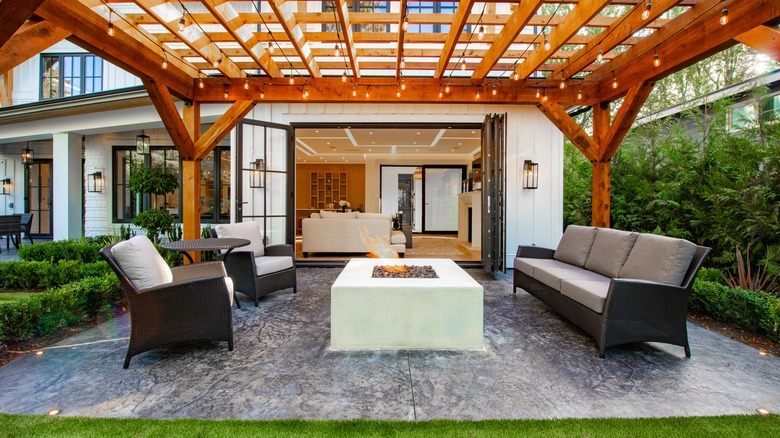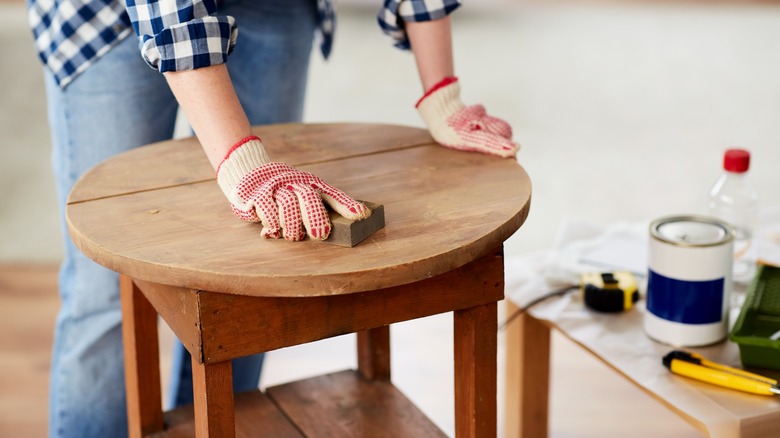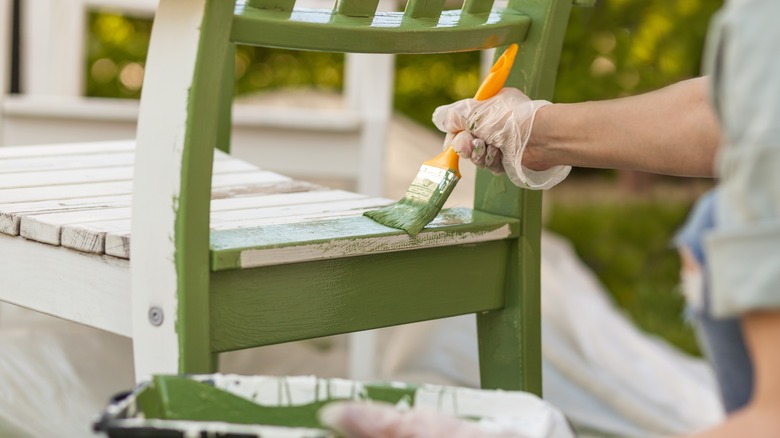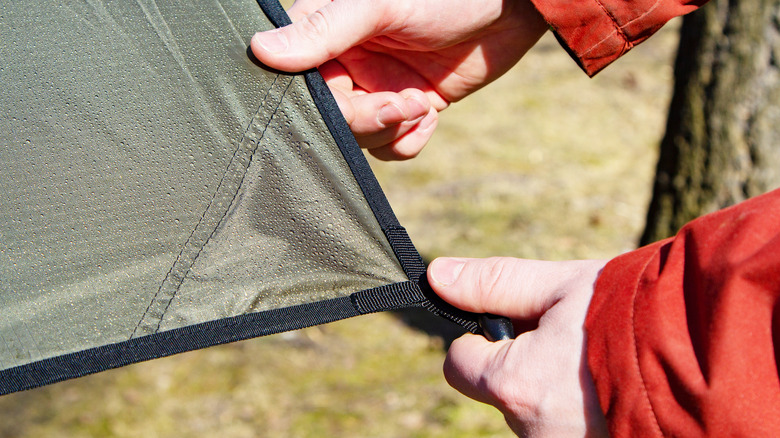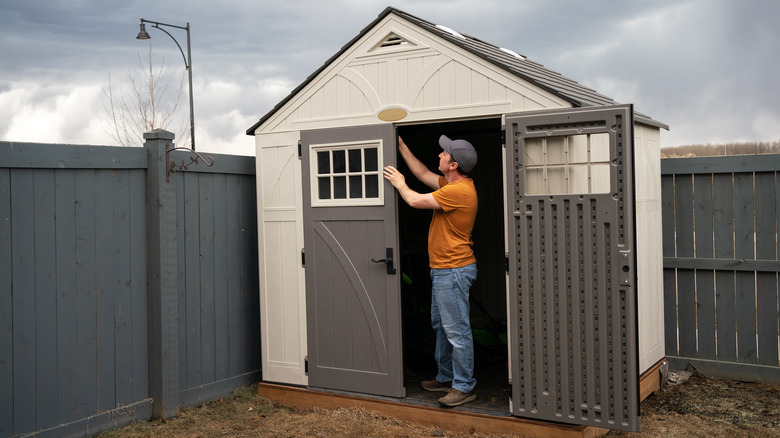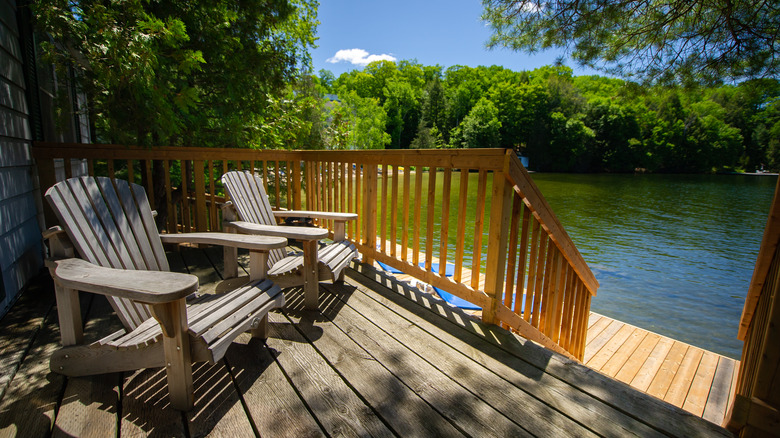How To Weatherproof Your Outdoor Furniture, According To An Expert
It's no secret that outdoor furniture can be almost as costly as interior furniture in many cases. There are so many options on the market, crafted from different types of materials to different fabrics if you've selected something with cushions. However, that investment isn't something you have to make every year or two — as Today's Patio reports, a lot of outdoor furniture can last well over a decade, up to 15 years. That is if you take care of it properly.
Unlike interior furniture, which can break down due to normal wear and tear from constantly using it, one of the biggest culprits for your outdoor furniture not lasting as long is the elements. As Proline Range Hoods explains, everything from sunshine to rain can potentially wear out your furniture more quickly. The key to its longevity is protecting it from those elements.
"An essential part of preparing your garden for the fall is ensuring your expensive garden furniture is weatherproofed, which isn't always as straightforward as it might seem," says Simon Barker, founder, editor, and lawncare expert at Grow Your Yard. "Giving your garden furniture a new coat of varnish is an obvious place to start, but there are other things you can do to protect your furniture and keep it looking its best."
In an exclusive interview with House Digest, Barker shared his expertise and gave us the inside scoop on exactly what to do to ensure your perfect outdoor furniture lasts for many seasons to come.
Repair wear and tear
The first step in protecting your outdoor furniture against the elements has absolutely nothing to do with weatherproofing — you need to begin by assessing the condition of your furniture pieces.
"Before you start weatherproofing your garden furniture, it's essential to check for any signs of wear and tear," Barker clarifies. In particular, he advises, "Look for cracks, chips, or flaking paint, and make sure that any moving parts are still in good working order. If you spot any problems, make sure you repair them before you start weatherproofing, as this will help extend your furniture's life."
Yes, this adds a bit of time to preparing your furniture for the cooler seasons. However, issues like furniture rust can potentially stain the cushions and other textiles that are likely being stored with it, which means you could end up ruining multiple pieces.
Plus, from a convenience standpoint, when you finally lug out all your furniture again as the warm weather approaches, the last thing you'll want to do is spend hours making repairs and fixing things. If you take the time to do so as the first step in the process, not only will it help with your furniture's longevity, as Barker indicates, but it'll also make things a lot more convenient in the future.
Apply a coat of paint or varnish
There's no denying that a simple coat of paint can have a huge impact on your interior space. It can give a room a whole new feel and immediately freshen it up. Paint or varnish can likewise be transformative on outdoor furniture, although for reasons beyond aesthetics.
"One of the easiest ways to weatherproof your garden furniture is to give it a new coat of paint or varnish. This will help to protect it from the elements and keep it looking its best," Barker recommends. Paint can help cover any discoloration that may have occurred due to the furniture being out in the elements for the season, from sun bleaching to stains from certain plants. Both paint and varnish also add an extra protective barrier, as Barker highlights.
However, don't just grab the first can of paint or varnish you see or think you can just use the leftovers you have from an interior project. For best results, you'll want to ensure you're using the right materials. "Make sure you use a good quality paint or varnish designed explicitly for outdoor use and apply a few coats for some added protection," advises Barker.
Depending on the material of your furniture, you may also want to get the recommendation of someone knowledgeable at your local hardware store or wherever you buy your paint and varnish. Wood furniture may require slightly different paint or varnish than metal furniture, for example.
Use tarps for protection
Something like paint or varnish is effective because it provides a barrier on every inch of your furniture, protecting every nook and cranny from the elements. However, if that seems too time-consuming or the weather turned faster than you thought and you hadn't gotten to your painting and varnishing yet, there's an effective alternative — tarps.
"If you don't have the time to varnish your furniture, one of the best things you can do is invest in some tarps," explains Barker. "Heavy-duty tarps are great for protecting garden furniture from bad weather and are relatively inexpensive."
Unlike paint or varnish, which requires that you sand away any imperfections in your furniture, apply multiple coats, and allow adequate time to dry, pulling a tarp over everything takes mere minutes. It's a great backup to have for unexpectedly bad weather as well. If winter comes a month earlier in your city than it typically does, a tarp might help do all the protective work you didn't get around to.
However, since tarps can easily become sails that catapult your furniture across the neighborhood, Barker has one last warning: "Don't forget to secure the tarps with bungee cords; you'll thank me on those inevitable windy days."
Storage your furniture in a shed or garage
There are certain tips and tricks to help protect your furniture from the elements, as Barker highlights. These are your best course of action if you have limited exterior space and no garage or anywhere with a roof where you could keep your outdoor furniture. After all, you likely don't want to lug it all indoors so that it takes up space in your house for months at a time. However, whenever possible, Barker advises, "If you're not going to use your garden furniture during the winter and have the space, put it into storage."
This is because all those protective strategies can only do so much, from adding a few layers of paint and varnish to meticulously arranging tarps over everything. "Even with the best weatherproofing tactics, your garden furniture will eventually succumb to the elements," explains Barker. "The most effective way to combat this is to store it in a safe, dry environment, ready for next year."
If you have plenty of space in a garage or a large shed, you won't have any issues with this. However, if space is at a premium at your property, this is something to keep in mind while shopping. Whenever possible, go for outdoor furniture that can be stacked, collapsed, or combined in some way, so it's easier to find storage space for your pieces.
Shop for weather-resistant materials
Prevention is far more effective than trying to repair the damage that's already been done. If you've already purchased all your outdoor furniture and aren't planning on switching it out anytime soon, this may not apply. In that case, do your best to put up barriers and pull your furniture indoors whenever possible. However, if you're looking to refresh your exterior space with new furniture, or are buying it for the first time, don't let aesthetics be your only consideration. You'll want to keep the material in mind for outdoor furniture that lasts for years.
"You can get a head start on weatherproofing by buying furniture more resistant to poor weather conditions," advises Barker. So, what materials should you be looking for? Well, if you're selecting wood furniture, make sure you know the type of wood the pieces are made of — it makes a difference. "When looking for garden furniture, always go for hardwoods with a high oil content," advises Barker. "Hardwood is a robust and durable material, and the high oil content is naturally water and rot-resistant."
If wood isn't really your style, or the wooden furniture pieces you love are out of our budget, Barker recommends, "Alternatively, you could look for furniture that's made from aluminum or stainless steel, both of which are rust-resistant."
